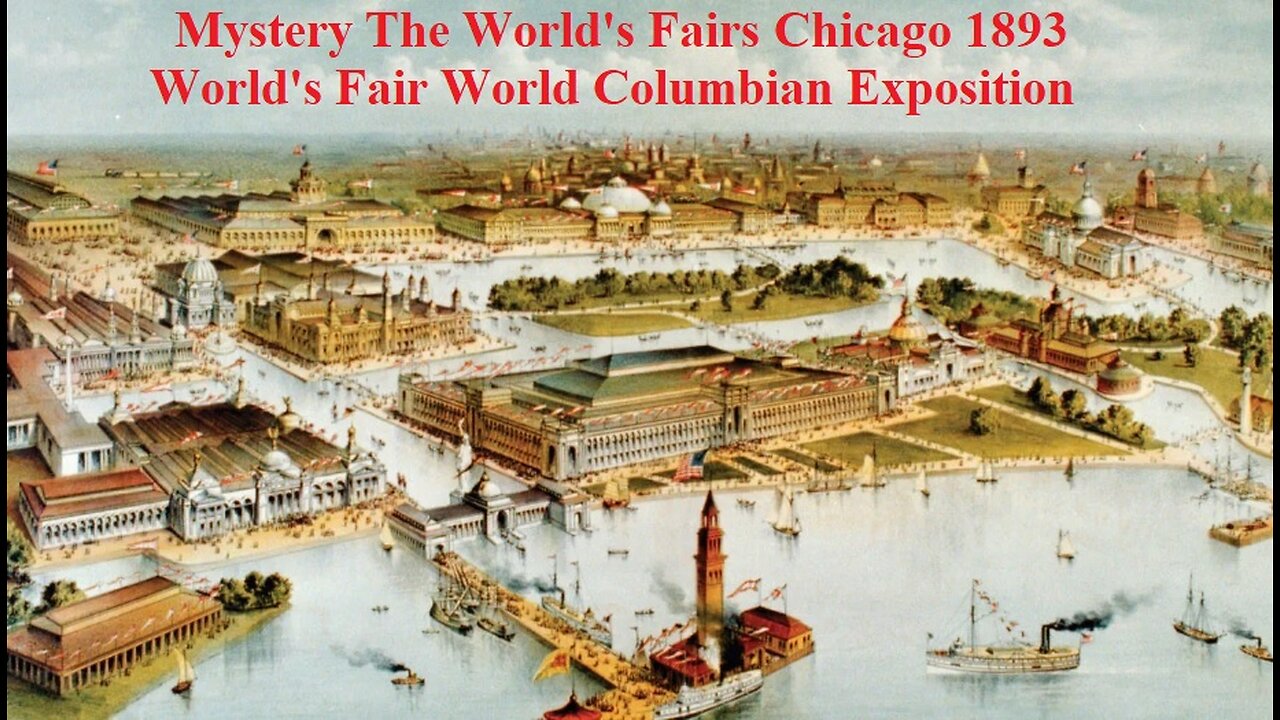Premium Only Content

Mystery The World's Fairs Chicago 1893 World's Fair World's Columbian Exposition
Mystery The World's Fairs Maybe the History we've been told is a lie! Were some ancient buildings built by a different race and their true history was covered up? Did ancient peoples have advanced forms of technology that have now been forgotten ? Was the massive kingdom of Tartaria visible on ancient maps much more advanced than we realize? This sub is an open forum for collaborative discussion of all topics "Tartaria" related, including Mud Flood, Tesla, AntiquiTech, Free Energy, Conspiracies, Hidden History, etc.
I wonder if this video has been posted here before? If yes, then i am not sorry for posting it again, because its just one helluva epic video. If not, I highly recommend watching it if you are interested in perhaps how Tartarian technology worked. I am still thinking about all the stuff he said and points out to us. As its a lot to deal with and can shake one up. I find it fascinating though.
Could it be that this civilization, split off from our official historical line of development, is behind many of the events of the 20th century?
And what of the World's Fairs? Were a large proportion of the World's Fair Buildings actually built from scratch, as the official historiography claims? There is much to suggest that the robber barons of the industrial age not only hid once widespread technological knowledge from us, but that they also hijacked some of the impressive architectural masterpieces in which parts of this knowledge was displayed.
Some of the buildings from the World's Fairs still exist today, and they are obviously not made of plaster or similar fragile materials. Were they subsequently rebuilt to be permanent structures? Is it even possible that the elaborately designed Expo sites were built with the technological capabilities of the time within just a few months, only to be destroyed again a few months later after the exhibitions had ended? Or is it plausible that after a great catastrophe the worldwide remains of the preceding high culture were not only systematically destroyed, but also pressed into an image of history imposed on us?
Some available information suggests that even after the worldwide, game-changing event we call the Reset or Mud Flood, there still remained countless complete and beautiful cities that were conquered by a new power elite and then repurposed as "World's Fairs".
Especially in America, the so-called New World, the many Greco-Roman cities would have been difficult to explain because in contrast to Europe, the Americas do not have an official greco-roman history.
The more carefully one investigates, the more difficult it becomes to find plausible explanations for the construction and destruction of these extraordinary and huge exhibition areas.
The official version about the World's Fairs can be summarized as follows: People in the 19th century loved Greco-Roman architecture for reasons unknown, so it was extremely important to the architects who organized the World's Fairs between 1850 and about 1914 to build in a classical style.
(Note: With World War I, classical architectural ambitions in Europe ended abruptly and many exhibitions also did not take place as planned. It was only in the wake of fascism that there was a return to ancient design principles, but these were often implemented superficially and were mainly applied to a few representative magnificent buildings. After the Second World War, on the other hand, classical architecture was deliberately replaced with new trends - e.g. Bauhaus and Brutalism. Officially the intention was to create an aesthetic distance to fascism, but in all likelihood its purpose was to cut the connection to the Old World through soulless, brutalistic architecture.)
No effort was spared for the world's fairs, enormous amounts of work went into creating complex statues, ornaments, columns, parks, buildings, and even the world's largest organs. No expenses were spared in the making of these massive structures. Made of plaster and linen or hemp fibers, they were only intended to last for the duration of the Expo. However the attention to detail was so great that purely visually there seemed to be no difference between the Expo buildings and the classical splendor-buildings of antiquity. The purpose of the World's Fairs was to make the supposedly "new" technologies discovered during the Industrial Revolution palatable to the masses, to create new markets. In the end, most of the buildings were torn down, with only meadows or empty parks remaining.
Chicago World's Fair, USA, 1893
On May 1, 1893, the city of Chicago held the "World's Colombian Exposition" to celebrate the "discovery" of America by Columbus 400 years earlier. In fact, the World's Columbian Exposition in Chicago was to be the largest to date. 70,000 exhibitors from 46 nations were present - 25,000 of them from the USA alone - to present their technical achievements, marking the beginning of a new era. Not only a film projector, the first dishwasher, a fully electric kitchen, an elevated train with electric drive and a rolling footbridge could be marvelled at, but also the amusement park with fairground stalls, circus performances, artificial ice rinks and an 80-meter-high Ferris wheel attracted numerous visitors.
The organizers of the fair which, given the historical background, may have been a coded message as well - except that the term "old world" may mean something different than what we learn nowadays.
The Chicago Expo, which makes us think involuntarily of ancient Rome, was nicknamed the "White City" and was the inspiration for the Emerald City in the book "The Wizard of Oz". Here is one of the sketches that illustrator W.W. Denslow made in response to the Chicago Expo for "The Wizard of Oz": The tops of the domes are studded with crystals - hence the name Emerald City in the book.
Here, Denslow stands against the backdrop of the Expo site after the devastating fire and on the verge of complete demolition.
Interestingly, Indian Researcher Praveen Mohan describes in his videos that many ancient Indian temples were originally studded with crystals at the top. Some, like the Somawathiya pagoda, still have those crystals today.
Does "The Wizard of Oz" contain an unconscious collective memory of humanity, or did Denslow possibly know something that is no longer available to us today?
In any case, the Chicago World's Fair was one of the most impressive exhibitions ever in architectural terms. According to the story presented to us, over 200 buildings were built on the shores of Lake Michigan on an area of 278 hectares, in only 3 years. Paradoxically, the construction period coincides with the period of economic depression, and the Panic of 1893 was the most severe economic crisis in the history of the United States to date. Who would have thought that in such a time there were enough workers and resources to build an almost paradisiacal city?
Were these buildings actually designed by architects Daniel Burnham and Frederick Law Olmsted and meant to be understood as a homage to Greco-Roman architecture, or did some of them already exist before the Expo began? Were they showing the public the remains of the old world one last time, only to destroy them afterwards?
Considering the immense effort that was necessary to construct the buildings, the official explanation hardly seems plausible, especially since there are only a few photos of the construction phase, or precise records of the course of the complex construction projects. This discrepancy between the functionality of the building as an exhibition object and the effort of construction is most evident in the colossal "Manufacturers and Liberal Arts Building".
This 200 meters wide and 500 meters long building required twice as much steel as the Brookyln Bridge, and was four times the size of the Roman Coliseum. It may even have been one of the largest buildings ever built. Covering an almost unimaginable area of about 20 football fields, this huge building housed numerous items from manufactories around the world that supposedly represented the level of technical expertise that had emerged since industrialization. This construction alone would have taken years and consumed numerous resources, even if you believe the official narrative of a temporary building. Nevertheless, the building was completely demolished after the Expo.
Of the more than 200 buildings, 14 (!) had similar dimensions to the "Manufactures and Liberal Arts Building" and they too were almost all destroyed after the 130-day duration of the exhibition. Today only two buildings remain, the so-called "Museum of Science and Industry" and the "World's Congress Auxiliary Building". Considering the high effort of the construction, the question arises why only two of these buildings were allowed to remain standing, since other possible uses would have been quite conceivable and it sounds very unbelievable that such immense resources were simply wasted.
Another interesting building at the Columbia Exposition was the main train station on the Expo grounds, whose entire rail system consisted of 35 tracks. By comparison, the main station in Munich, one of the largest stations in Germany, has only 34 tracks. Allegedly, the entire station was only temporary in nature, but it begs the question of how it would even be possible to build a station in such a way that it was stable and functional, but still "temporary" in nature? The only photo of the alleged construction of the station building shows a building already completely finished amidst mud - it appears to have been nothing more than freshly painted. Of the construction process itself, according to our research, not a single photo exists.
A few months after the Expo, the station burned to the ground along with other buildings at the exhibition. Cause of the fire: Arson by unknown.
The official story is this: A security guard at the Expo, conveniently called C. Mason, noticed the fire in the casino, and also immediately tried to sound the alarm. Unfortunately, none of the five devices to activate the fire alarm worked, which he tried out in quick succession. Fortunately, he eventually found a phone, so he was finally able to report the fire. By then, however, it was already too late, and due to changed official procedures, only ten fire trucks were able to arrive at the scene instead of the usual 20.
It is also possible that this fire and subsequent demolition shortly after the Expo ended is related to the Great Chicago Fire of 1871. There are some contradictions with this fire. Officially, the cause of the Great Chicago Fire was that a cow knocked over a lantern. Evidence for this theory was never presented.
Were the remains of the old world destroyed here in two phases, first with the city fire that claimed the lives of some 17,500 buildings, and later with the demolition of the Expo site? Were there even two separate fires? Were there fires at all? Questions upon questions.
Supposedly, by the mid-19th century, Chicago had rapidly developed from a small Indian settlement into the huge metropolis we know today. But again, there is no documentation of the logistics of city planning. Interestingly, Chicago appears with the name Chilaga on old maps. So was this possibly an important Old World city and was Chilaga deliberately renamed Chicago to obscure its history?
If we look at the "White City" of the Expo mentioned earlier from this point of view, the area could in fact have been a government district of Chilaga that was converted to a modern Expo area. So, did the 27 million people who visited the "exhibition" actually witness the destruction of one of the last parts of Chilaga?
The statue of the Republic, which was on display at the Chicago World's Fair, holds in its right hand a sphere on which an eagle with outstretched wings is enthroned, while its left hand adorns a staff with a Phrygian cap, which was a symbol of the Scythians or Tartars and presumably symbolized freedom and justice. In the course of the Age of Enlightenment, the Phrygian cap continued to be used as a symbol of freedom.
Significantly, in the same year that the Chicago Expo was being planned, the new University of Chicago was founded, considered one of the most important private American university foundations of the era, generously supported by oil magnate John D. Rockefeller. And this very university bears in its coat of arms a griffin burning in a fire, in which one could also recognize a symbol for the destruction of the old world empire. Some symbols, such as the double-headed eagle, the mythological griffin, the quadriga (i.e. four-horse), and the lion, we encounter again and again in the context of the old world.
CHICAGO, UNITED STATES 1893
World's Columbian Exposition
Dates Open - May 1 to October 30, 1893. 179 days open to public, including all Sundays, except 4 - May 7, 14, 21 & July 23. (Those 4 were open to exhibitors, passholders, etc., amounting to a total of only 27,144 visitors).
Attendance - 21,480,140 Paid; 27,539,521 Total.
International Participants - 50 Nations and 26 Colonies.
Total Cost - $27,291,715. (Total expenditure $28,340,700 less Div.-Chi. $500,000 & Capital stock 10% $548,985 for Actual Expenses of $27,291,715.) U.S. States and Territories spent an additional $6.02 million and Foreign Exhibitors $6 million.
Site Acreage - 686.1 acres in what is now Chicago's Jackson Park.
Sanction and Type - Prior to the Bureau of International Exhibitions. Would be considered a Universal style Registered event today like those on the 0 years of the decade. Act of Congress provided that the President of the U.S. would issue a proclamation of time and place and extend invitations to foreign nations to participate in the World's Columbian Exposition.
Ticket Cost - Various different types of tickets were used, including Souvenir Tickets (4 designs, Columbus, American Indian, Washington, Lincoln: 6 million ordered, good for any day). Plain Tickets (good only on date of sale) 25 million ordered. Passes for free admissions, including photo pass, complimentary card of admission to high dignitaries, workmen's passes (good for 1 month), return checks were used for those with passes who had to leave and re-enter the grounds each day. Daily ticket 50 cents. After May 22, a children's ticket (age 6-12, under 6 free) cost 25 cents. Later, during October 10-21, children from 6-18 admitted for 10 cents. Originally gates were open from 8 a.m. to 7 p.m., extended to open 7:30 a.m. to 11 p.m.
The World's Columbian Exposition may have been the most majestic World's Fair of all-time with resplendent buildings that would be credited for starting the trend of architecture that would extend to many government buildings in the United States for centuries. To many, it was the White City. Alabaster coatings, actually staff plaster, on the temporary buildings, of which most were constructed, gleaned in the sun. Nearly two hundred acres of the fair site was covered by the buildings. The fair, on the more whimsical side, introduced the Ferris Wheel within the eighty-five acres of amusement known as the Midway Plaisance. The Ferris Wheel seated 2,160 passengers, the all-time biggest.
Chicago had not won the right to hold the Columbian in an easy fashion. Washington, D.C. began developing a plan for a three year exposition in 1885 that would begin with the Centennial Anniversary of the Constitution's adoption and last through the 400th Anniversary of America's discovery. New York, Chicago, and St. Louis also wanted to host. Chicago won, chosen as host city by Congress with approval on April 25, 1890.
Above photo. Palace of Mechanical Arts, 1893, Francis Benjamin Johnston. Below: East entrance to the Manufacturer's Building, 1893, Souvenir Photo Company. Photos courtesy Library of Congress.
Jackson Park was an uninviting tract of swamps, sand, and scrub prior to the event, but over the next three years would be transformed into an ornamental arrangement of lakes, canals, and buildings on built-up land, using 120,000 cubic yards of dirt. Once the buildings were constructed, the expo authority held a dedication on October 21, 1892 in a program lasting three days. That program was used to disseminate information about the exposition the following year. Opening Day of the expo occurred on Monday, May 1. The Opening ceremonies were held in the Grand Plaza at the west end of the Court of Honor with President Cleveland in attendance. The paid admission that day was 128,965. Low attendance followed during the first week, and an impending financial crises loomed overhead, culminating eight days later with the failure of Chemical National Bank of Chicago and its branch at the exposition. That low attendance did not last.
There were seven distinct parts of the exposition: the Basin and the Canal with architecture of the Grand styles; the wooded island; the Government location where the United States and other foreign pavilions were built; Federal State location with the Fine Arts building as its hub; the Midway Plaisance; Live Stock, outdoor Agricicultural Exhibits, Convent of La Rabida, Leather, Forestry, Dairy and Anthropological buildings; plus a region of railway yards, storehouses, bonded warehouses, and workshops of fair and concessionaires. Of course, the buildings and exhibits within them were the stars, plus that Midway.
The buildings covered one hundred and sixty-seven acres. Administration 1.18 acres, Agriculture 13.35, Art 5.98, Electricity 6.09, Fisheries 2.16, Government 3.57, Horticulture 5.46, Machinery 18.26, Manufactures 30.88, Mines 5.65, Transportation 16.16, Womans 1.89, Minor buildings 37.43, State Buildings 10.35, Foreign buildings 3.11, Concession (Midway buildings, booths, etc.) 18.38, Other 7.27.
Beyond the exhibits within those buildings, the World's Columbian was known for its Congresses with different Congresses held each week, over two hundred in all, including the Department of Woman's Progress, Department of Public Press, Temperance, Moral and Social Reform, Music, and more.
It was a success by any means, even turning a profit, per World's Fair accouting. The White City spurred the City Beautiful Movement plus a building boom in similar architectural style at state capitals around the nation, and amazed the public who came. Receipts of concessionaires themselves totaled $16,583,051.53, of which the exposition took nearly a 25% cut.
Minute Walk in History
World's Columbian Exposition 1893
From the World's Fair that many historians think of as the best, one that spawned many a city hall, the White City movement in architecture, and continued the idea, begun in Philadelphia 1876, that the United States was now an equal to its European counterparts. Filled with public domain photos from the 1893 World's Columbian Exposition Illustrated, the World's Columbian Exposition, and the Library of Congress, with words from the official broadsheet of the fair, as well as music written for the fair, the Chicago Day Waltz, step back in time to one of the best world expos ever.
Historian's Perspective
Prasch - "Chicago was pioneering in several ways. The White City created for the fairground, on land largely reclaimed from Lake Michigan, was an architecturally unified ensemble. This was in some ways controversial - especially among architects, who found the style regressive and unmodern - but it was hugely popular among mass media and fairgoers. Chicago also featured a systematic anthropological approach to the display of non-European peoples, even if this was undercut to a large degree by the Midway. This was already implicit, I think, in, say, London 1886, or Paris 1878, but not, I think, in this kind of systematic way. Perhaps more significantly, Chicago pioneered the "Midway Plaisance," site of Ferris Wheel and Little Egypt's bellydancing and much else. Some of this was carried over from previous fairs, as well, but reaches new heights in Chicago, where the separate entertainment sphere, given over to private enterprise, is most fully developed. And no fair would be complete without a midway after 1893. The city made its case in the competition for a site, and pretty much proved it in its carrying out of the fair."
Leonard Levitan - "Chicago 1893 introduced the Ferris Wheel, Picture Postcards, and established the Souvenir as a valuable momento, kicking off a giant new industry in America. They produced hundreds of unique items for that event and it is a collector's paradise today. It also introduced grand European architecture and the concept of intelligent urban planning to America whose cities at that time were growing helter skelter with no fixed plan as immigrants folled in (i.e. - New York). It is no coincidence that Fredric Olmstead was one of the planners. Every bank built in America after 1893 showed this influence.
Sources: Report of the President of the Board of Directors of the World's Columbian Exposition, Chicago 1892-3; World's Columbian Exposition Illustrated - Devoted to the Interests of the Columbian Exposition, Art and Literature; Book of the Fairs, Columbian; The Final Official Report of the Director of Works of the World's Columbian Exposition, Daniel Burnham; Chicago's Great World's Fairs; Chicago's White City of 1893; "The Chicago World's Fair of 1893, the World's Columbian Exposition," Norman Bolotin and Christine Laing; Story of Exhibitions; New York Times; London Times; Historical Dictionary of World's Fairs; Fair News.
International Participants
Nations and Colonies
Algeria (C), Argentina, Austria, Australia (C), Barbados (C), British Guiana (C), British India (C), British West Indies (Leeward Islands)(C), Great Britain and possessions, Belgium, Brazil, Bolivia, Bulgaria, Cape of Good Hope (C), Canada, incl. Alberta, China, Chile, Ceylon (C), Corea (See Korea), Costa Rica, Cuba (C), Curaco (Dutch W Indies) (C), Columbia, Dahomey (C), Danish West Indies (C), Denmark, Dutch Guiana (Suriname) (C), Dutch West Indies (C), East Indian (C), Ecuador, Egypt (C), France and possessions, Germany, Greece, Guatemala, Haiti, Hawaii (Sandwich Islands), Honduras, Hungary, Islands of the Pacific, Italy, Jamaica (C), Japan, Jahore (C), Korea, Liberia, Madagascar (C), Mexico, Monaco, Morocco, Netherlands and colonies), New Zealand (C), New South Wales (C), Nicaragua, Norway (Norway, even though twinned with Sweden at time, considered nation with separate building), Orange Free State, Paraguay, Peru, Persia, Phillipine Islands (C), Poland (listed w/Russia), Portugal, Puerto Rico (C), Russia, Salvador, Samoa , San Domingo (C), Scandinavian (Not country, but could have been several together), Servia, Siam, Sweden, Spain, Syria (C), Switzerland, Tunis (C), Trinidad (C), Turkey, United States, Uruguay, Venezuela.
Nations/Colonies with Buildings - 19. Costa Rica, Colombia, Guatemala, Venezuela, Spain, Ceylon, New South Wales, Turkey, Brazil, Canada, Sweden, Japan, France, Germany, Great Britain, Haiti, Norway, East India.
State Buildings - Arkansas, Iowa, Ohio, California, Joint Territories, Pennsylvania, Kentucky, Kansas, South Dakota, Connecticutt, Louisiana, Colorado, Maine, Massachusetts, Texas, Delaware, Maryland, Utah, Michigan, Florida, Minnesota, Virginia, Missouri, West Virginia, Montana, Vermont, New York, Wisconsin, New Hampshire, Washington, New Jersey, Idaho, Nebraska, Illinois, North Dakota, Indiana.
A variety of sources list different participants. The Official Report Pass List and Official Report Department of Works, plus the Illustrated History, and other lists at times differ. Some are listed with buildings, exhibits, and/or as concessions. Use the above as a guide, not gospel.
Expo Tidbits
Chicago Day, held on the anniversary of the burning of Chicago on 10-9-1871, was the highest attendance day with 716,880 paid admissions.
The exposition used more electricity than the whole city of Chicago at that time.
There was a Moveable Sidewalk taking visitors down Casino Pier and back, even though the tower that was supposed to be built at the end as an attraction had never been built. An intramural railway circled the grounds, cost 10 cents for a 20 minute ride at 12 mph. There was also a Sliding Railway and Ice Railway as well as Gondolas plying the various canals and lakes.
The Midway Plaisance included the following attractions; Congress of Beauty, Irish Industrial Association, Hindoo Jugglers, Electric Scenic Theater, Venice Murano Co., Donegal Castle, Hagenbeck Arena, Japanese Bazaar, Samoan Village, Japanese Village, Jahore Bungalow, Turkish Village, Streets in Cairo, Bernese Alps, Frances Triocea, Pompeii Pavilion, Moorish Palace, Persian Palace, Eiffel Tower, Algerian Village, Volcano of Kilauea, Old Vienna, Lapland Village, Captive Balloon, Dahomey Village, Great East Show, Chinese Village, French Cider Press, Bulgarian Booth, German Village, and more.
Capacity of restaurants on site was 30,000 people per hour.
Legacies
Field Columbian Museum, now the Museum of Science & Industry in Palace of Fine Arts Building in Jackson Park. The museum opened to the public on June 2, 1894. There was land for University of Chicago, Chicago's first elevated transit line, and other benefits, including the tangible and more intangible: it provided employement during hard times, spurred investment throughout the state, increased outside recognition of Chicago's potential, attracted visitor dollars and generated tax revenue, and helped propel the area's image as economic powerhouse. From the Midway, the original Ferris Wheel would make it to St. Louis in 1904, but eventually turn to scrap. It left a legacy of those wheels at amusement parks which still lasts today. The Maine Building was moved to Maine in Poland Spring and is open to the public in the summer. The Dutch House was moved to Brookline, Massachusetts and is now a tourist attraction. The Norway Building is located in Blue Mounds Wisconisin, and is open to visitors.
Those in Charge
Daniel Burnham was the leader and architect of the 1893 fair. Grand plan of the exhibition layout was designed by Frederick Law Olmstead, with all principal buildings with both land and water frontage. Lyman Gage chosen president of corp with Thomas B. Bryan and Potter Palmer as Vice President. Gage later replaced prior to opening by William Baker and he, during the fair term, by H.N. Higinbotham. George R. Davis was Director-General.
Purpose of the World Exhibitions
If it is true that many of the buildings at the World's Fairs already existed and were only renovated, then the destruction of these buildings is one of the largest cover-ups in recent history. Also, this would be further proof that pretty much all countries were already controlled by the cabal 100 years ago, and modern politics was intended from the beginning as a means to infiltrate and control cultures. The systematic destruction of knowledge and the theft of cultural goods and property by the church continued seamlessly with the advent of more contemporary nation states. With the help of a central monetary system imposed on us, state-legitimized robbery is still the main cause of the transfer of wealth and possessions into the hands of a few.
The misappropriation of majestic old-world building sites by the new post-colonial power elite happened at the same time as other events that all seem to be connected. Thus, from the mid-19th century onwards, not only were World's Fairs held in oversized and far too expensive buildings that were completely inappropriate for them, but at the same time the first psychiatric hospitals ("insane asylums") were being built. Just like the world exhibitions, these psychiatric hospitals were architecturally unsuitable for the defined purpose. Architecture always reflects the consciousness of the builders and is defined by its purpose. However, we would expect industrialists to build simply and economically, to use steel and concrete, and by no means to demolish their buildings immediately, but to try to generate income from land and buildings for as long as possible. But we see just the opposite - the buildings at the World's Fairs are detailed, ornate, aesthetic, and far too large and expensive for their purpose. They represent something completely different from the world we know. They represent ancient Rome, the classical ideals of the beautiful, the true, the good; the pursuit of the divine and perfection.
The World's Fairs connect two completely opposite eras (or cultures) that should have no points of contact at all - the world of the industrial robber barons and an old world that we can no longer remember, but in which the economic principles we know played no great role.
Greatest Story Ever Un-Told 10 Parts Set and This 1893 World Columbian Exposition In Chicago Is Really A 1,000 Years Old City From Past Antiquitech Tartarian Empire and the True Believers in the “Tartaria” conspiracy theory that 100s of old world fairs 1801 thru 1940 era are convinced that the elaborate temporary fairgrounds built for events like the Panama-Pacific International Exposition in San Francisco in 1915 and 100s of other city were really the ancient capital cities of a fictional empire !
"Expositions are the timekeepers of progress. They record the world's advancement. They stimulate the energy, enterprise, and intellect of the people; and quicken human genius. They go into the home. They broaden and brighten the daily life of the people. They open mighty storehouses of information to the student. Every exposition, great or small, has helped to some onward step." President William McKinley, speaking at the 1901 Pan-American Exposition in Buffalo, NY.
The 1893 World Columbian Exposition in Chicago inaugurated an age of great fairs and expositions in the United States whose influence is felt to this day. The Chicago Exposition and the similar events that followed in Buffalo, NY; St. Louis, MO; Seattle, WA, San Francisco, CA and New York, NY dramatized technology and the fine arts, and illuminated the era ahead, as industrialism took hold, immigration peaked, science moved ever forward, and a vibrant, multi-faceted American music culture grew throughout the country.
Though the 1876 Philadelphia Centennial Exposition in Philadelphia had been a great success, the Chicago Exposition took its immediate inspiration from the Exposition Universelle held in Paris in 1889. Like all previous world's fairs, the Paris exposition hosted music and other entertainment among its exhibits, but in greater variety and on a much larger scale. A major work, Esclarmonde, was commissioned from French composer Jules Massenet and was performed nightly. Music from all over the world was heard, including Javanese gamelan, which was to have a profound effect on composer Claude Debussy. Fairgoers could also hear indigenous music at the village nègre, where some 400 Africans from European colonies spent the duration of the fair demonstrating their culture and crafts. A similarly conceived Algerian Village was also an attraction.
The organizers of the Chicago Exposition would try to match or outdo the 1889 Exposition in every way. For awhile, they even thought of creating a structure taller than the Eiffel Tower built for the 1889 fair, and the tallest building in the world at the time. In the end, they settled for a spectacular city-within-a-city that sprawled over 600 acres and featured 65,000 exhibits. "The White City," so named for its many white buidlings that were made even brighter by the night-time illumination supplied by General Electric, captured the imagination of the country, and drew over 27 million paying customers during its run from May 1st to October 30th, 1893. Within its walls, fairgoers could marvel at the ever-multiplying technological wonders of the age, enjoy art exhibits, concerts and sports; listen to lectures on various topics, view short films in the world's first dedicated movie theater, or ride the original Ferris Wheel.
The basic human desires for community, stories (the more outrageous the better) and the need to feel like a protagonist in a wider struggle are what pulls us from moments of real social, economic and cultural dislocation into fabricated histories. Buildings and cities are made to grow old, to outlast people, and to be a testament to these cultural histories. They’re a yardstick for a culture’s ability to endure. When they’re not given the chance to do this, the contradiction can break something loose, and send people scavenging for cultural memory that feels ancient enough to anchor them in an uncertain now.
Sullivan aptly describes here the poisoned rebirth of pseudo-classicism in the 20th century - the attempt to imitate the old structures without having understood the architectural principles. We always see two fundamentally different types of architecture in the photos of the expos - on the one hand, the massive, classicist buildings, with uniform and harmonious proportions of the golden ratio. They do not differ in the slightest from the real European renaissance buildings, because in fact they come from the same era. On the other hand, we also see cheap-looking, actually temporary buildings made of plaster and other cheap materials, which do not originate from any known historical epoch and which were obviously built with the intention of tearing them down again as quickly as possible.
Many temporary structures were erected around the old buildings for the Expos - e.g. cheap pavilions, walls made of plaster and imitations of famous buildings, but after the Expos not only the temporary but also the old buildings were demolished.
Did the World's Fairs perhaps serve, among other things, as an instrument to give people a national identity after the unified culture had collapsed? The separation into nations seems artificial - the Slavs, for example, seem just like the Germans of Nordic origin and thus part of the same people. The term "Slav" originated from the pejorative term "sclavi", was put into the world by the Vatican and stood for the "pagan" tribes of Europe who did not want to submit to the monotheistic power apparatuses. After the successful infiltration of the German cultural area, only the pagan Eastern Europeans were referred to as "Slavs". In fact, most of the nations we know today were not founded until after 1850 - modern Egypt, for example, only in 1953, after the British conquest. Illyria, the homeland of the Illyrians, became the Balkans after annexation by France. Free Tartary became Uzbekistan, Persia became Iran in 1935, the Ottoman Empire became Turkey in 1923, and so on. The old words have a meaning - our whole past resonates in them. When these words are spoken, that alone establishes a real connection with the past. By losing these words, we also lose that connection, and with it, the connection to our ancestors. Meanwhile, our world is divided into various soulless administrative units, controlled by a small secret elite.
It was at the Expos that people first came into contact with the "new technologies" - telephones, railways, electric light (i.e. the light bulb), wireless communication, incubators, cars, photography, films. In addition, the supposed realities of life in the colonies were also frequently depicted (Africa, South America, etc.). The creation of the patent system played an important role in building the monopolies - because only with patents it was possible to own knowledge and thus technologies, and thus control people.
The foundation of the world we live in today was laid then during the time of the world expositions. The technological knowledge of the old world was selected: One part of the knowledge was kept secret, the other part was presented to the public. One of the most important criteria in this decision-making process was whether a technology could be controlled by a central authority. Any form of free energy must have been very dangerous to the forces that controlled the robber barons of the industrial age from the shadows. It is important to understand that these industrialists had not earned their wealth themselves - they were born into elite families and chosen to play a predetermined role.
Only since the dawn of the 20th century has the attitude prevailed that one must take something from others in order to be able to have something oneself. Competition took the place of cooperation. These two opposing world views - cooperation and competition - can be visualized as follows: With a circle and a pyramid.
The competition system is pyramidally organized. It involves an authoritarian chain of command that requires absolute obedience. At the level of the intelligence services, this system is represented by the "need-to-know" principle. Competitive thinking can only arise in a hierarchically organized society. In this society, energy flows from the masses at the base upward to the top of the pyramid, where it may even be absorbed or consumed by non-earthly entities. At the top seems to be what is named in mythological, religious and esoteric lore as Satan, Antichrist, Evil, or the Demiurge. At the base of the pyramid are people who feel powerless, basically slaves. Success in this system is defined by making it "to the top". This always implies that on the way up you oppress other people - take something away from them. The further up you go, the more powerful you feel. Energy is represented or symbolized by money in this system. The money system was built in such a way that, in the sense of the pyramidal system, it gradually directs people's life energy to the top of the pyramid. We can assume that this is also where the true reason for the existence of the fiat money system is hidden: to rob people of their life energy.
We already encounter the connection between parasitic, paranormal beings, the monetary system and the oppression of humanity in the work "Momo" by the author Michael Ende: men in grey, called time thieves, steal people's time. These interdimensional parasites convince the adults that they can save time by depositing it in a time savings bank. The adults believe the promises of the men in gray. In reality, the more they save, the less time they have - the time they save is lost to them. Life gradually becomes sterile and bleak. Buildings become standardized and all look the same, just like clothes. No one lives in the present anymore, no one has time for each other and life becomes hectic. Only the children recognize the cold, vicious nature of the gray men, as they are still in touch with their own aliveness. The adults fall prey to the idea of having to save time and so their lives become increasingly bleak and grey. But the Gray Men are gradually able to cast their spell over the children as well. Only Momo can resist the cold, psychopathic power of the Grey Men. Outside of space and time, she defeats the Men in Grey, frees the stolen time, and gives people back their vitality and the love in their hearts.
It's amazing, by the way, that in the novel Momo lives in an old, decaying Roman amphitheater surrounded by dreary, modern new buildings. Momo represents the connection to the old world. She represents life. When Momo defeats the men in gray, the last one says with relief, "Finally it's over!" Michael Ende realized that evil has no existence of its own. It is only a shadow, a black hole, the absence of something. Evil can only exist as long as there are people running away from themselves and their own aliveness. The parasites are our own creation. The destruction of the parasites is the triumph of man over his own contradictory nature and his dark side.
Power and powerlessness are in truth only two sides of the same coin, and also in karmic terms everything has its price. Every experience of power is always based on a corresponding experience of powerlessness, even if these experiences are separated on a temporal level. A good metaphor for the pyramidal system is a black hole that absorbs all light, consumes everything and releases nothing - it is a one-way street. That's why secret societies exist in the first place - in a pyramidal system, the relevant decisions have to be made in the shadows and no one is allowed to know the people making the decisions. The system is like a hydra, and we can only see some of their heads. Evil is always absorbing, consuming, calculating, inward looking. It closes itself to life, to exchange and to truth.
Possibly in the old world, on the other hand, people were integrated into a cycle. Everything was cyclical and in balance. People knew that they had nothing to lose by giving to others. In these communities, people lived for each other - on an energetic level, energy flowed freely between them without flowing outward. In these small, healthy communities there were no authoritarian hierarchies, no chains of command, no parasitic forces. Authorities evolved naturally, and people with natural authority were keen not to abuse their power, as this would have resulted in expulsion from the communities. The system, built on cooperation, includes multiple rings running concentrically outward. In the center is the "heart" - the wisest, most intelligent, most capable people in the community. Unlike the pyramidal system, these people do not hide, for they need not fear transparency. Even architecture reflected this concentric system. For example, in the round city of Baghdad, or Atlantis, which was supposedly built in rings. From the center or heart of the city, life moves outward in rings. The city wall separates the city from the outside world, creating a self-contained, living system. Goodness is outwardly radiant, giving, without ulterior motive and without expecting anything in return. It is its own cause, its own source, and has enormous radiance.
This is a chronological list of international or colonial world's fairs.
https://en.wikipedia.org/wiki/List_of_world's_fairs
All elaborate temporary fairgrounds built are removed after the fair is over.
Real Timeline Of Deception Part 0 Exploring Tartaria 1000 Years
Exploring Tartaria - Old World Secrets Revealed
https://rumble.com/v2u8ef4-real-timeline-of-deception-part-0-exploring-tartaria-1000-years-added-to-ou.html
Real Timeline Of Deception Part 1 Exploring Tartaria 1000 Years
The Timeline Deception - Part I - Exploring Tartaria
https://rumble.com/v2ua8sa-real-timeline-of-deception-part-1-exploring-tartaria-1000-years-added-to-ou.html
Real Timeline Of Deception Part 2 Exploring Tartaria 1000 Years
The Timeline Deception - Part II - Exploring Tartaria
https://rumble.com/v2ubf4w-real-timeline-of-deception-part-2-exploring-tartaria-1000-years-added-to-ou.html
Real Timeline Of Deception Part 3 Exploring Tartaria 1000 Years
The King of Tartaria - Exploring Tartaria
https://rumble.com/v2ueih6-real-timeline-of-deception-part-3-exploring-tartaria-1000-years-added-to-ou.html
Real Timeline Of Deception Part 4 Exploring Tartaria 1000 Years
The Saints - Relics, Reliquaries, & The First Resurrection
https://rumble.com/v2ugl92-real-timeline-of-deception-part-4-exploring-tartaria-1000-years-added-to-ou.html
Real Timeline Of Deception Part 5 Exploring Tartaria 1000 Years
The Saints - The Ruling Class - Exploring Tartaria
https://rumble.com/v2uij7w-real-timeline-of-deception-part-5-exploring-tartaria-1000-years-added-to-ou.html
Real Timeline Of Deception Part 6 Exploring Tartaria 1000 Years
From Atheism, Agnosticism, New Age, Protestantism, to Roman Catholicism
https://rumble.com/v2ujvr6-real-timeline-of-deception-part-6-exploring-tartaria-1000-years-added-to-ou.html
Real Timeline Of Deception Part 7 Exploring Tartaria 1000 Years
The Millennial Kingdom of God - Exploring Tartaria
https://rumble.com/v2uldss-real-timeline-of-deception-part-7-exploring-tartaria-1000-years-added-to-ou.html
Real Timeline Of Deception Part 8 Exploring Tartaria 1000 Years
Magic of the White City 1893 Chicago World's Fair
https://rumble.com/v2un20g-real-timeline-of-deception-part-8-exploring-tartaria-1000-years-added-to-ou.html
Real Timeline Of Deception Part 9 Exploring Tartaria 1000 Years
1000 Years Added To Our History & Dark Ages Never Existed
https://rumble.com/v2uo07i-real-timeline-of-deception-part-9-exploring-tartaria-1000-years-added-to-ou.html
Real Timeline Of Deception Part 10 Exploring Tartaria 1000 Years
Church History - Complete Documentary AD 33 to Present
https://rumble.com/v2uprfu-real-timeline-of-deception-part-10-exploring-tartaria-1000-years-added-to-o.html
Real Timeline Of Deception Part 11 Exploring Tartaria 1000 Years
Christmas Unveiled - Pied Piper - Templars Secret - Saturn's Workshop - Giants Stealing Children
https://rumble.com/v2urmd0-real-timeline-of-deception-part-11-exploring-tartaria-1000-years-added-to-o.html
Real Timeline Of Deception Part 12 Exploring Tartaria 1000 Years
Ancient Cloning Factories - Foundlings - Incubators - Test-Tube Babies
https://rumble.com/v2uu8ck-real-timeline-of-deception-part-12-exploring-tartaria-1000-years-added-to-o.html
Real Timeline Of Deception Part 13 Exploring Tartaria 1000 Years
Homunculus Unveiled - Jesus - Artificial Generation - Liber Vaccae - Lost Esoteric Secrets
Archaix Chronology Anunnaki Sumerian Gods Crystalinks Timelines 2040B.C. 2046A.D.
Archaix 2.0 Doomsday Chronology Five color charts with extensive Legend-chronology; exhibits 62 dates involving 300 events in linear timeline combining the Phoenix and Nemesis X Object appearances, the Mayan Long-Count baktuns and the Anunnaki NER 600 year periods, a history spanning over 74 centuries to May 2040 and November 2046.
The Lost History of Earth (Ewaranon) W0W - A Must See Video Lost Earth
Everything we were taught about the Earth, History, Science, Space, Energy and our Civilization was a lie. This mind blowing documentary will shift your perspective of the world monumentally.
The Secret Life of Symbols with Jordan Maxwell Knowledge of the Heavens, Life on Earth
Ancient Religions From Alpha To Stone Age To Omega To Modern Times To Infinity
This 11.5 Hrs. Full Documentary With Sound Is About Ancient Religions From Alpha To Stone Age To Omega To Modern Times To Infinity.
Everything we were taught about the Earth, History, Science, Space, Energy and our Civilization was a lie. This mind blowing documentary will shift your perspective of the world monumentally.
Proofs Earth Is Not A Spinning Ball What The Hell Happened 200 Times Collection
Proofs Earth Is Not A Spinning Ball When a photo of spherical Earth is pointed out to flat-earthers, they will dismiss it as CGI in the blink of an eye; even if they haven’t done any analysis at all. They do this because their belief in flat-Earth is not evidence-based, and any evidence contrary to their beliefs needs to be invalidated no matter how. They are so used to doing it, and sometimes they become confused by it themselves, to the point that they would take the slightest hint of digital manipulation of any picture of the Earth as evidence of the flat Earth.
Mystery The World's Fairs 00 This Evidence Hidden History Chronological All World’s Fair's - https://rumble.com/v49zfro-mystery-the-worlds-fairs-this-evidence-hidden-history-chronological-all-wor.html
Mystery The World's Fairs 01 London 1851 Crystal Palace Works Industry All Nations - https://rumble.com/v49xr6f-mystery-the-worlds-fairs-london-1851-crystal-palace-works-industry-all-nati.html
Mystery The World's Fairs 02 Paris 1855 World's Fair L'Exposition Universelle de Paris # 1 - https://rumble.com/v49wmff-mystery-the-worlds-fairs-paris-1855-worlds-fair-lexposition-universelle-de-.html
Mystery The World's Fairs 03 Paris 1867 World's Fair L'Exposition Universelle de Paris # 2 - https://rumble.com/v49vttt-mystery-the-worlds-fairs-paris-1867-worlds-fair-lexposition-universelle-de-.html
Mystery The World's Fairs 04 Philadelphia 1876 Fair Centennial International Exposition - https://rumble.com/v49us5z-mystery-the-worlds-fairs-philadelphia-1876-fair-centennial-international-ex.html
Mystery The World's Fairs 05 Paris 1878 World's Fair L'Exposition Universelle de Paris # 3 - https://rumble.com/v49soh6-mystery-the-worlds-fairs-paris-1878-worlds-fair-lexposition-universelle-de-.html
Mystery The World's Fairs 06 Paris 1889 World's Fair Exposition Universelle de Paris # 4 - https://rumble.com/v49pdu3-mystery-the-worlds-fairs-paris-1889-worlds-fair-exposition-universelle-de-p.html
Mystery The World's Fairs 07 Chicago 1893 World's Fair World's Columbian Exposition - https://rumble.com/v49ryc5-mystery-the-worlds-fairs-chicago-1893-worlds-fair-worlds-columbian-expositi.html
Mystery The World's Fairs 08 Lyon 1894 Fair L'Exposition Internationale et Coloniale - https://rumble.com/v49qjd3-mystery-the-worlds-fairs-lyon-1894-fair-lexposition-internationale-et-colon.html
Mystery The World's Fairs 09 Nashville Tennessee 1897 Centennial International Exposition - https://rumble.com/v49obhi-mystery-the-worlds-fairs-nashville-tennessee-1897-centennial-international-.html
Mystery The World's Fairs 10 Omaha 1898 Nebraska Trans-Mississippi Exposition Part 1 - https://rumble.com/v49kvne-mystery-the-worlds-fairs-omaha-1898-nebraska-trans-mississippi-exposition-p.html
Mystery The World's Fairs 11 Omaha 1898 Nebraska Trans-Mississippi Exposition Part 2 - https://rumble.com/v49ls22-mystery-the-worlds-fairs-omaha-1898-nebraska-trans-mississippi-exposition-p.html
Mystery The World's Fairs 12 Buffalo 1901 New York World's Fair Pan American Exposition - https://rumble.com/v49dg39-mystery-the-worlds-fairs-buffalo-1901-new-york-worlds-fair-pan-american-exp.html
Mystery The World's Fairs 13 St. Louis 1904 World's Fair Louisiana Purchase Exposition - https://rumble.com/v49h2n9-mystery-the-worlds-fairs-st.-louis-1904-worlds-fair-louisiana-purchase-expo.html
Mystery The World's Fairs 14 Louisiana 1904 Purchase Exposition St. Louis World's Fair - https://rumble.com/v49bv7t-mystery-the-worlds-fairs-louisiana-1904-purchase-exposition-st.-louis-world.html
Mystery The World's Fairs 15 Seattle 1909 World's Fair Alaska Yukon Pacific Exposition - https://rumble.com/v499353-mystery-the-worlds-fairs-seattle-1909-worlds-fair-alaska-yukon-pacific-expo.html
Mystery The World's Fairs 16 San Francisco 1915 Panama-Pacific International Exposition - https://rumble.com/v49aa13-mystery-the-worlds-fairs-san-francisco-1915-panama-pacific-international-ex.html
Mystery The World's Fairs 17 1962 Seattle Chronological All International World’s Fair's - https://rumble.com/v49is0f-mystery-the-worlds-fairs-1962-seattle-chronological-all-international-world.html
Antiquitech Tartarian Empire Old World's Fairs 18 Before The World's Fair 1851 Thru 1974 - https://rumble.com/v4968hi-antiquitech-tartarian-empire-old-worlds-fairs-before-the-worlds-fair-1851-t.html
Chicago Old Museum Tell About 1,000 Year 19 Old World History Of 1893 World's Fair - https://rumble.com/v2cphwy-chicago-old-museum-tell-about-1000-year-old-world-history-of-1893-worlds-fa.html
Chilaga Where Chicago Is Now On Map 20 of America and 1893 World’s Columbian Exposition - https://rumble.com/v2cqmdc-chilaga-where-chicago-is-now-on-map-of-america-and-1893-worlds-columbian-ex.html
Antiquitech Tartarian Empire Greatest Story 21 Ever Un-told Rewriting Recorded History - https://rumble.com/v36porm-antiquitech-tartarian-empire-greatest-story-ever-un-told-rewriting-recorded.html
Welcome To Our Channel 2.4 Million+ Views In 2023 & 596 Video's So Far This Year Alone - Thanks To Everyone Who Like Us... Good Or Bad You Are All Welcome To Share Any Video's We Post To Your Friends And Other's... Thanks !
-
 47:58
47:58
What If Everything You Were Taught Was A Lie?
25 days agoExposing Everyone And Everything A Epstein Survivor Interview Human Trafficking Child Sex Ring
5.17K5 -
 LIVE
LIVE
LFA TV
14 hours agoLFA TV ALL DAY STREAM - MONDAY 8/11/25
6,003 watching -
 LIVE
LIVE
Chicks On The Right
3 hours agoMTG fighting w/Levin, Pritzker humiliated by Welker, Mamdani squeals like a girl, and psychotic libs
1,758 watching -
 LIVE
LIVE
The Bubba Army
2 days agoAlligator Alcatraz Closed?! - Bubba the Love Sponge® Show | 8/11/25
3,665 watching -
 29:03
29:03
DeVory Darkins
15 hours ago $6.40 earnedDemocrat Governors painfully HUMILIATED Trump drops BRUTAL WARNING for DC officials
7.03K57 -
 14:44
14:44
Preston Stewart
18 hours ago $1.15 earnedTrump's Cartel Crackdown
5.08K6 -
 1:05:58
1:05:58
Sarah Westall
15 hours agoForces Creating Massive Instability Worldwide: US, Ukraine, China, Israel, Colonel Douglas Macgregor
15.3K34 -
 2:02:19
2:02:19
BEK TV
2 hours agoTrent Loos in the Morning - 8/11/2025
6.22K -
 3:45:16
3:45:16
Badlands Media
1 day agoThe Narrative Ep. 34: The World Eater
111K41 -
 29:39
29:39
Afshin Rattansi's Going Underground
1 day agoProf. Jeffrey Sachs: Will The Trump-Putin Meeting End the Ukraine Proxy War and Avert Nuclear War?
24.8K109